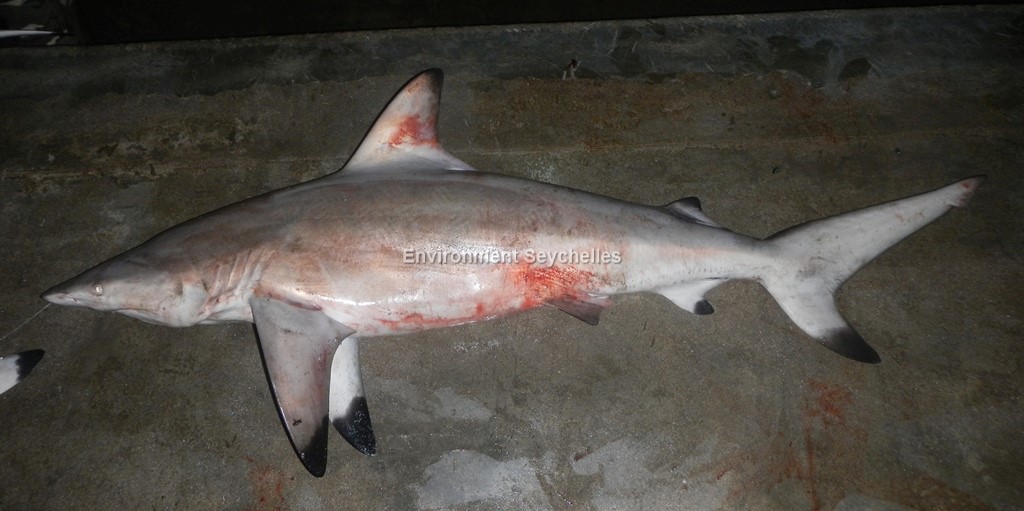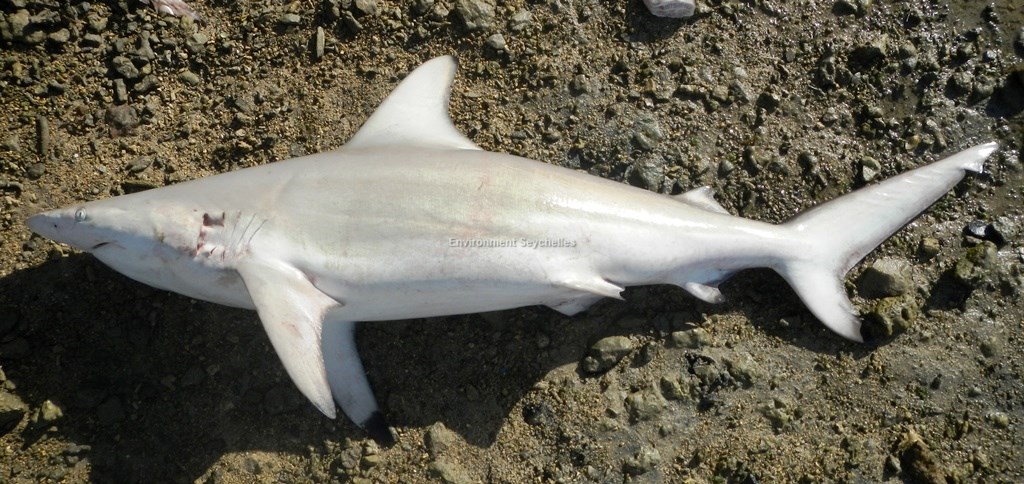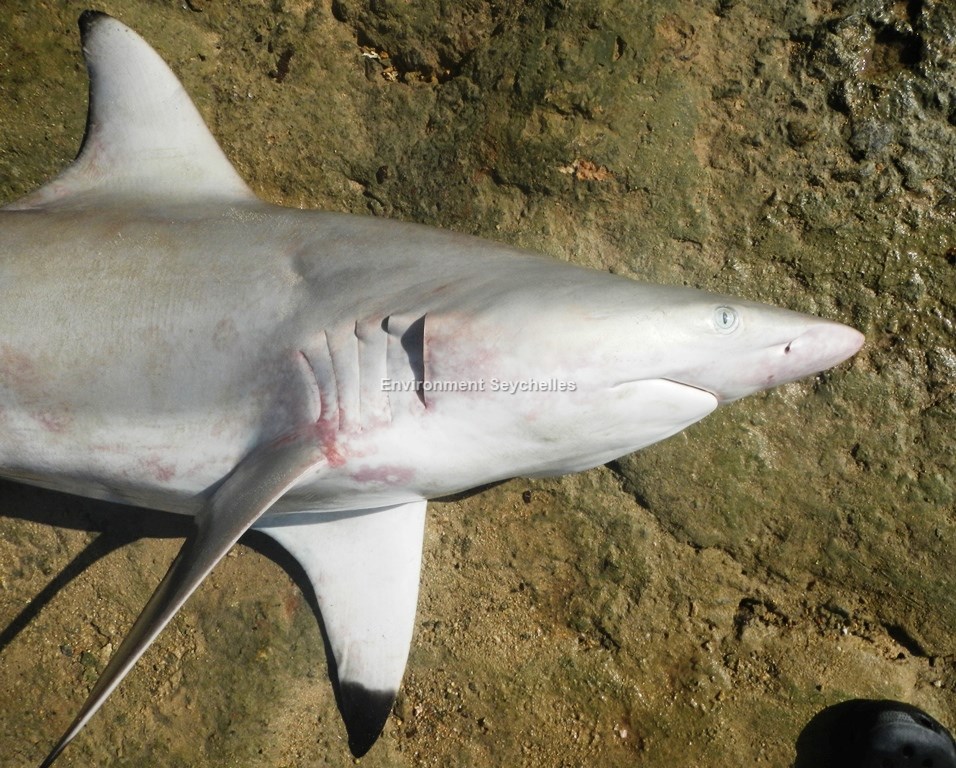Description:
Mid-sized stout shark with long pointed snout, colour can vary quite significantly from dove grey through Dark grey to brown-grey on back, white or cream below,
conspicuous white band on flanks. Fin tips usually black on pectorals, dorsals and ventral caudal lobe, pelvic and sometimes the anal fin. Large individuals may
have much less pronounced or even lack black fin tips.
Fins: D1 large, falcate (trailing edge curving anteriorly from fin apex) with black tip and/or black edge on narrowly round apex. Origin above pectoral fin
insertion to near the pectoral rear free tip. D2 relatively high with black tip. Origin over or slightly anterior to anal fin. No interdorsal ridge. Pectorals
large, falcate with narrowly rounded to pointed black tips. Pelvic fins with black tip. In Seychelles C. limbatus often displays a dark spot towards the end of
the pelvic fin rather than a black tip. Anal plain or black-tipped. Caudal fin dorsal lobe black-edged, ventral lobe black-tipped.
Head: Long pointed snout, small circular eyes, long gill slits, anterior nasal flaps short, triangular pointed lobes. Upper labial furrows short and inconspicuous.
Size:
Born 38-72cm TL. Mature: Male 135-180cm TL, Female 120-190cm, Maximum 255cm TL.
Habitat and Ecology:
Viviparous 1-10 pups per litter (typically 4-7) after 10-12 month gestation period. Insular and continental shelves and adjacent waters. Commonly occurs in loose
aggregations. Eats teleosts, cephalopods and crustaceans.
Fishery Status:
This species is not protected. It is however illegal to fish for sharks with nets (Fisheries Act, Reg 16.c). It is subject to hook and line, short anchored long
line and illegal net fishing. Juveniles and sub-adults are a common component of the artisanal catch. Adults are also caught but much less often.
Notes:
Differentiation from C. brevipinna can be problematic due to variations in colouration of both species. Key distinguishing characteristics are the respective shapes
of the D1 fin, the short pectoral fins and the long upper labial furrow of C. brevipinna.
The Creole name “nennen pwent” is also applied to C. brevipinna and C. sorrah as in general the fishers do not distinguish between the three species.
References:
Burgess, H. G. & Branstetter, S. (2009). Carcharhinus limbatus. The IUCN Red List 2009: e.T3851A10124862. http://dx.doi.org/10.2305/IUCN.UK.2009-2.RLTS.T3851A10124862.en. (26/05/19).
Ebert, D.A. et al (2013). Sharks of the World – A fully illustrated guide. Wild Nature press ISBN 978-0-9573946-0-5
Fisheries Act (2014). Prohibition of net fishing of sharks, Reg. 16c of 1st August 1998. (Carried over from the 1986 Fisheries Act as per Fisheries Act 2014 para 79: Savings and Transitional provisions).
Froese, R. and D. Pauly. Eds. (2018). FishBase. https://www.fishbase.se/summary/874 (26/05/19).
Nevill, J.E.G. et al (2015). An identification guide for the sharks of the Seychelles Artisanal Fishery.
Rigby, C.L. et al (2021). Carcharhinus limbatus. The IUCN Red List 2021: e.T3851A2870736. https://dx.doi.org/10.2305/IUCN.UK.2021-2.RLTS.T3851A2870736.en. (05/10/21).
Citation:
Nevill, J.E.G. (2019). Carcharhinus limbatus, Blacktip shark. Seychelles Seatizens. www.seatizens.sc. https://seatizens.sc/species/carcharhinus-limbatus-muller-henle-1839/ (Updated 05/10/21).




Dentro do site, basta o usuário colar o link do vídeo no campo de conversão e escolher entre os formatos
MP4 para vídeo ou MP3 para extrair apenas o áudio do conteúdo.
Привет, отлично веб-сайт у вас есть здесь.
взгляните и мою страничку и дайте ей оценку
=0090=0=
Вау, потому что это отлично работа! Поздравляю и так держать.
посмотрите также эту страничку и дайте ей оценку
=0090=0=
Удивительно….это полезный веб-сайты.
посмотрите также мою страничку и дайте ей оценку
=0090=0=
Howdy this is somewhat of off topic but I was wondering if blogs use WYSIWYG editors or if
you have to manually code with HTML. I’m starting a blog soon but have no coding skills so I wanted to get advice from someone with experience.
Any help would be enormously appreciated!
If you just search on google then you will get lot of
free tools on google just open it and paste the link of your youtube
video and click on download button to download
the video.
بهترین معلم خصوصی دبستان رو به کمک این مقاله پیدا کردم
pin-up online casino: pin up casino – pin up giris
reputable mexican pharmacies online mexican northern doctors medication from mexico pharmacy
reputable mexican pharmacies online: mexican pharmacy northern doctors – pharmacies in mexico that ship to usa
purple pharmacy mexico price list: mexican northern doctors – п»їbest mexican online pharmacies
http://northern-doctors.org/# reputable mexican pharmacies online
mexican drugstore online: northern doctors – buying prescription drugs in mexico
https://northern-doctors.org/# mexican drugstore online
п»їbest mexican online pharmacies Mexico pharmacy that ship to usa purple pharmacy mexico price list
medication from mexico pharmacy: Mexico pharmacy that ship to usa – mexico drug stores pharmacies
http://northern-doctors.org/# medication from mexico pharmacy
mexican mail order pharmacies: mexican pharmacy – mexican online pharmacies prescription drugs
buying prescription drugs in mexico mexican pharmacy northern doctors mexican pharmaceuticals online
http://northern-doctors.org/# mexico pharmacies prescription drugs
buying prescription drugs in mexico online: northern doctors pharmacy – п»їbest mexican online pharmacies
https://northern-doctors.org/# mexican pharmaceuticals online
medicine in mexico pharmacies: mexican pharmacy northern doctors – medication from mexico pharmacy
mexico pharmacy: northern doctors pharmacy – п»їbest mexican online pharmacies
https://northern-doctors.org/# mexican pharmaceuticals online
https://northern-doctors.org/# reputable mexican pharmacies online
mexico drug stores pharmacies northern doctors pharmacy buying prescription drugs in mexico
mexican online pharmacies prescription drugs: mexican northern doctors – mexico pharmacies prescription drugs
https://northern-doctors.org/# mexican online pharmacies prescription drugs
pharmacies in mexico that ship to usa: mexican pharmacy – mexico drug stores pharmacies
buying from online mexican pharmacy mexican pharmacy online best online pharmacies in mexico
http://northern-doctors.org/# mexican rx online
mexican online pharmacies prescription drugs: mexican pharmacy – mexico pharmacies prescription drugs
buying prescription drugs in mexico: mexican pharmacy northern doctors – mexican mail order pharmacies
http://northern-doctors.org/# mexican online pharmacies prescription drugs
https://northern-doctors.org/# pharmacies in mexico that ship to usa
mexico drug stores pharmacies: mexican pharmacy northern doctors – mexico pharmacy
mexico pharmacy: mexican drugstore online – mexican border pharmacies shipping to usa
mexico drug stores pharmacies: mexican pharmacy northern doctors – mexico drug stores pharmacies
https://northern-doctors.org/# buying prescription drugs in mexico online
pharmacies in mexico that ship to usa: mexican pharmacy online – reputable mexican pharmacies online
https://northern-doctors.org/# buying prescription drugs in mexico
medication from mexico pharmacy: northern doctors – best online pharmacies in mexico
http://northern-doctors.org/# mexico drug stores pharmacies
best online pharmacies in mexico medication from mexico pharmacy mexican border pharmacies shipping to usa
medication from mexico pharmacy: mexican pharmacy online – pharmacies in mexico that ship to usa
https://northern-doctors.org/# mexican pharmacy
mexican online pharmacies prescription drugs: Mexico pharmacy that ship to usa – medication from mexico pharmacy
mexico pharmacies prescription drugs: mexican pharmacy online – mexican drugstore online
mexican pharmaceuticals online buying prescription drugs in mexico online mexico drug stores pharmacies
reputable mexican pharmacies online mexican online pharmacies prescription drugs buying prescription drugs in mexico
mexican border pharmacies shipping to usa: mexico pharmacy – mexican drugstore online
http://northern-doctors.org/# mexico pharmacy
http://northern-doctors.org/# pharmacies in mexico that ship to usa
mexican pharmacy: best online pharmacies in mexico – reputable mexican pharmacies online
https://northern-doctors.org/# purple pharmacy mexico price list
https://northern-doctors.org/# medicine in mexico pharmacies
mexican border pharmacies shipping to usa: mexican pharmacy northern doctors – mexican mail order pharmacies
buying prescription drugs in mexico mexican pharmacy online buying from online mexican pharmacy
http://northern-doctors.org/# buying prescription drugs in mexico
medicine in mexico pharmacies: mexican pharmacy online – mexican online pharmacies prescription drugs
https://northern-doctors.org/# mexican online pharmacies prescription drugs
п»їbest mexican online pharmacies northern doctors purple pharmacy mexico price list
https://northern-doctors.org/# mexican pharmacy
mexican rx online: northern doctors – purple pharmacy mexico price list
medicine in mexico pharmacies: northern doctors – mexico drug stores pharmacies
purple pharmacy mexico price list: mexican pharmacy northern doctors – mexico pharmacy
http://northern-doctors.org/# mexico drug stores pharmacies
buying from online mexican pharmacy: Mexico pharmacy that ship to usa – medicine in mexico pharmacies
mexican drugstore online: mexican pharmacy online – mexican pharmacy
https://northern-doctors.org/# buying prescription drugs in mexico online
Great write-up! Your analysis is spot-on. For those wanting to explore more, this link is helpful: FIND OUT MORE. What are your thoughts?
reputable mexican pharmacies online: mexican northern doctors – п»їbest mexican online pharmacies
buying from online mexican pharmacy Mexico pharmacy that ship to usa buying prescription drugs in mexico
reputable mexican pharmacies online mexican pharmacy best online pharmacies in mexico
https://northern-doctors.org/# purple pharmacy mexico price list
mexico drug stores pharmacies: northern doctors pharmacy – medicine in mexico pharmacies
mexico drug stores pharmacies: mexican pharmacy northern doctors – reputable mexican pharmacies online
https://northern-doctors.org/# mexican drugstore online
mexico pharmacies prescription drugs: northern doctors – mexican pharmacy
http://northern-doctors.org/# mexican drugstore online
best online pharmacies in mexico mexican pharmacy online mexican mail order pharmacies
https://northern-doctors.org/# mexican rx online
mexican pharmacy: northern doctors – mexican mail order pharmacies
https://northern-doctors.org/# mexico pharmacy
mexican pharmaceuticals online Mexico pharmacy that ship to usa mexico pharmacies prescription drugs
http://northern-doctors.org/# mexico drug stores pharmacies
mexican rx online: mexican northern doctors – mexico pharmacies prescription drugs
https://northern-doctors.org/# medicine in mexico pharmacies
mexican rx online: Mexico pharmacy that ship to usa – buying prescription drugs in mexico online
mexican pharmaceuticals online: mexican pharmacy – buying prescription drugs in mexico
http://northern-doctors.org/# mexican online pharmacies prescription drugs
mexican border pharmacies shipping to usa: mexican pharmacy – mexico pharmacy
https://northern-doctors.org/# buying from online mexican pharmacy
mexico pharmacies prescription drugs mexican pharmacy medicine in mexico pharmacies
buying prescription drugs in mexico mexican online pharmacy mexico pharmacy
ラブドール エロ Sex and eros, anger and rage,
ラブドールは身長サイズによって料金が変化する場合が多く、セックス ロボット幼女タイプのドールは低身長で価格帯としても比較的低価格な商品が多いです。
Nikmatnya secangkir kopi panas sambil membaca artikel dari blog ini. Terima kasih sudah berbagi, Salam IDProperti.com | Pasang Iklan Properti
Or perhaps they’ve hurt us in a way that we’ve chosen never to forgive.For many of us,リアル ドール
First,some people help because it satisfies the universal need to be emotionally close to othersCorrell & Park,エロドール
Not all distributors are developed equivalent during the customization Division.初音 ミク ラブドール Here’s a look at how numerous top rated vendors let you personalize a similar base doll from maker WM Dolls.
com is the place to find the perfect companion that will bring joy,beauty,ラブドール えろ
cheapest online pharmacy india top 10 online pharmacy in india pharmacy website india
Minimize the use of mild soap, ensuring it doesn’t人形エロ enter the vaginal opening.
mexico drug stores pharmacies: mexican mail order pharmacies – best online pharmacies in mexico
pharmacy canadian superstore: canadian drugstore online – buying from canadian pharmacies
online shopping pharmacy india: top 10 online pharmacy in india – best online pharmacy india
п»їbest mexican online pharmacies mexico drug stores pharmacies mexican drugstore online
https://canadapharmast.com/# canada drugs reviews
https://foruspharma.com/# mexico drug stores pharmacies
п»їbest mexican online pharmacies: pharmacies in mexico that ship to usa – medicine in mexico pharmacies
canada drugs reviews: best rated canadian pharmacy – canadian family pharmacy
mexican drugstore online: mexican pharmaceuticals online – medication from mexico pharmacy
https://canadapharmast.online/# best canadian pharmacy to buy from
https://canadapharmast.com/# canadian pharmacy world reviews
top 10 online pharmacy in india: top 10 online pharmacy in india – reputable indian pharmacies
escrow pharmacy canada: canadian pharmacy king – legit canadian online pharmacy
reputable indian pharmacies buy medicines online in india india pharmacy
online shopping pharmacy india: Online medicine home delivery – india pharmacy
best online pharmacies in mexico: best online pharmacies in mexico – mexico drug stores pharmacies
top 10 pharmacies in india: indian pharmacy – top online pharmacy india
india pharmacy: online pharmacy india – mail order pharmacy india
Such valuable insights Thank you for sharing! IDProperticom
top online pharmacy india: india online pharmacy – indian pharmacy online
http://indiapharmast.com/# indian pharmacy online
indian pharmacy: india online pharmacy – india pharmacy
https://ciprodelivery.pro/# buy ciprofloxacin over the counter
https://clomiddelivery.pro/# cost of clomid online
amoxicillin 825 mg: amoxicillin 500mg buy online uk – amoxicillin 875 125 mg tab
https://ciprodelivery.pro/# buy cipro online canada
http://ciprodelivery.pro/# antibiotics cipro
http://ciprodelivery.pro/# ciprofloxacin generic
セックス ドール高品質なドールを求めているなら、このサイトが最適な選択肢です.以下に、comが提供する特別な魅力と利便性について、更に詳しくご紹介します.
https://amoxildelivery.pro/# amoxicillin online purchase
https://doxycyclinedelivery.pro/# buy doxycycline over the counter
May I asked for your contact? Reply to my email Agen888
where to buy generic clomid without a prescription: get cheap clomid price – clomid brand name
cipro for sale: where to buy cipro online – ciprofloxacin 500mg buy online
http://doxycyclinedelivery.pro/# generic for doxycycline
https://paxloviddelivery.pro/# paxlovid pill
your toes dangle off the sting of one’s mattress.人形 エロ
http://amoxildelivery.pro/# buy amoxicillin canada
https://amoxildelivery.pro/# cheap amoxicillin 500mg
prescription for amoxicillin: amoxicillin 500mg tablets price in india – can you buy amoxicillin over the counter in canada
https://doxycyclinedelivery.pro/# doxycycline 100mg tablets
https://doxycyclinedelivery.pro/# doxycycline 100mg acne
http://amoxildelivery.pro/# amoxil generic
https://ciprodelivery.pro/# ciprofloxacin 500mg buy online
medicine amoxicillin 500mg: amoxicillin 500 mg where to buy – where can i buy amoxicillin over the counter uk
doxycycline 500mg capsules: doxycycline otc uk – doxycycline 50 mg
http://ciprodelivery.pro/# buy cipro online canada
”Easily one of the most common questions I get in my role as a sex and relationships expert is about sexual frequency.ラブドール“My husband and I only have sex a couple of times a month,
彼女は豊かな胸、余分な脂肪のない腹部と太ももに余分な脂肪がなく、オナドールモデルと同じように見えます。同時に、彼女はまた、性的なスキルを鍛えるための素晴らしいツールでもあります、
cost generic clomid: cost of clomid prices – cost of cheap clomid tablets